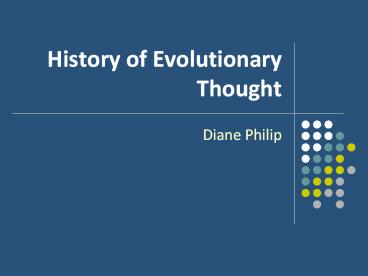History of Evolutionary Thought - PowerPoint PPT Presentation
Title:
History of Evolutionary Thought
Description:
History of Evolutionary Thought ... (1809 1882) was born at Shrewsbury in northwestern England. He was sent to Edinburgh University at age 16 to study medicine. – PowerPoint PPT presentation
Number of Views:381
Avg rating:3.0/5.0
Title: History of Evolutionary Thought
1
History of Evolutionary Thought
- Diane Philip
2
I. What is Evolution?
- Evolution a gradual process by which the living
world has been developing following the origin of
life.
3
II. 18th and 19th centuries
- Species were thought to have a fixed form.
- Species defined mostly by their morphology
(appearance). - World was believed to be perfectly designed and
earth was very young.
4
II. 18th and 19th centuries
- Classification system based on assumption that
species were static (unchanging). - Carl Linnaeus (1708-1788) created hierarchical
classification scheme with binomial naming (genus
species). - Classification used as a method of organizing,
not a way to show relationships.
5
III. Early Ideas of Evolution
- George Louis Leclerc (1707-1778) French
naturalist who first suggested evolution. - George Cuvier (1769-1832) Vertebrate zoologist
who suggested Catastrophism (Mass extinction). - James Hutton (1726- 1797) Proposed the
Uniformatarian Theory of geology. - Theory states that geologic processes happen at
the same rate today that they have throughout the
earths history.
6
III. Early Ideas of Evolution
- Jean Baptiste Lamarck (1744-1829) French
naturalist and taxonomist. He proposed the Theory
of Acquired Characteristics.
7
IV. Enter Darwin (1809-1882)
- Early Life
- Charles Darwin (18091882) was born at Shrewsbury
in northwestern England. - He was sent to Edinburgh University at age 16 to
study medicine. - In 1827 he was sent to Cambridge University to
become an Anglican clergyman.
8
IV. Enter Darwin (1809-1882)
- Voyage of the H.M.S Beagle
- Asked by Capt. Robert FitzRoy on a voyage to
chart South America coast in 1831. - Read Principles of Geology by Charles Lyell,
which discussed theory of uniformitarianism.
Wanted to extend it to all animals. - Noticed family resemblance between species
(living and fossil) in areas he studied.
9
IV. Enter Darwin (1809-1882)
- Galapagos Observations
- different islands, climates, vegetation
- differences in animals (tortoise finch)
- could these differences be the result of the
differences among islands? - could each animal have come from a common
ancestor?
10
IV. Enter Darwin (1809-1882)
- Development of Natural Selection
- Malthus said as the human population outgrows
its resources, members must compete for what is
available. - Darwin thought the same principle might apply in
nature. - Individuals with favorable traits might have an
advantage in survival and reproduction. - Favored individuals would pass their traits on to
their offspring.
11
IV. Enter Darwin (1809-1882)
- Darwin and Alfred Russel Wallaces papers were
presented as a scientific meeting in 1858 but
received little fan fare. - Darwins findings were published in a book On
the Origin of Species in 1859.
12
V. Neo-Darwinian Synthesis
- After about 1870, scientific evidence piled up
against natural selection - The Earth was too young.
- Apparent swamping of favorable variations.
- Lack of transitional forms in the fossil record.
- Biologists convinced that evolution had occurred
but no longer saw natural selection as its chief
mechanism - The main scientific objections to Darwinian
natural selection theory were answered by the
1930s - Discovery of radioactivity and later studies of
decay rates showed age of earth to be 4 billion
years. - Swamping inheritance problem and lack of
transitional forms in fossil record both resolved
by Mendelian genetics.































